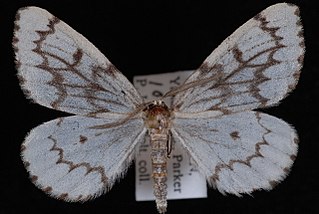Nemoria rubrifrontaria, the red-fronted emerald, is a species of moth in the family Geometridae, in the superfamily Geometroidea. The species was described by Alpheus Spring Packard in 1873. It is found in North America.
Hydriomena macdunnoughi is a species of moth in the family Geometridae. It was described by Louis W. Swett in 1918 and is found in North America, where it has been recorded from Yukon Territory to western Alberta and Colorado.
Nepytia janetae is a species of moth in the family Geometridae . It was described by Frederick H. Rindge in 1967 and is found in North America.
Pero radiosaria is a species of moth in the family Geometridae. It was described by George Duryea Hulst in 1886 and is found in North America, where it has been recorded from southern California to Texas.
Stenoporpia glaucomarginaria is a species of geometrid moth in the family Geometridae. It was described by James Halliday McDunnough in 1945 and is found in North America.
Pherne subpunctata is a species of geometrid moth in the family Geometridae. It is found in North America.

Operophtera danbyi is a species of geometrid moths in the family Geometridae described by George Duryea Hulst in 1896. It is found in North America.
Drepanulatrix hulstii is a species of geometrid moth in the family Geometridae. It was described by Harrison Gray Dyar Jr. in 1904 and is found in North America.
Caberini is a tribe of geometrid moths in the family Geometridae. There are at least 50 described species in Caberini.
Idaea retractaria is a species of geometrid moth in the family Geometridae. It was described by Francis Walker in 1861 and is found in North America.
Stenoporpia vernata is a species of geometrid moth in the family Geometridae. It was described by William Barnes and James Halliday McDunnough in 1910 and is found in North America.

Nepytia phantasmaria, the phantom hemlock looper, is a species of geometrid moth in the family Geometridae. It was described by Herman Strecker in 1899 and is found in North America.
Idaea basinta, the red-and-white wave, is a species of geometrid moth in the family Geometridae. It was described by William Schaus in 1901 and is found in Central and North America.
Lobocleta granitaria is a species of geometrid moth in the family Geometridae. It was described by Alpheus Spring Packard in 1871 and is found in North America.

Pero occidentalis, the western pero, is a species of geometrid moth in the family Geometridae. It was described by George Duryea Hulst in 1896 and is found in North America.
Heterophleps refusaria, the three-patched bigwing, is a species of geometrid moth in the family Geometridae. It was described by Francis Walker in 1861 and is found in North America.
Digrammia atrofasciata is a species of geometrid moth in the family Geometridae. It was described by Alpheus Spring Packard in 1876 and is found in North America.
Glena quinquelinearia, the five-lined gray, is a species of geometrid moth in the family Geometridae. It was described by Alpheus Spring Packard in 1874 and is found in North America.
Erastria decrepitaria is a species of geometrid moth in the family Geometridae. It is found in Central America, North America, and South America.

Erastria cruentaria, the thin-lined erastrium, is a species of geometrid moth in the family Geometridae. It is found in North America.





